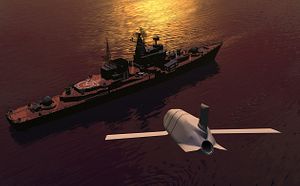The U.S. Navy is making slow but steady progress in acquiring new anti-ship long-range strike capabilities. According to an April 3 press statement, the service successfully tested Lockheed Martin’s new Long-Range Anti-Ship Missile (LRASM) this week by releasing a prototype of the weapon from an F/A-18E/F Super Hornet for the first time.
“The jettison release of the first LRASM from the Super Hornet is used to validate the aerodynamic separation models of the missile,” the statement reads. “This successful test event paves the way for flight clearance to conduct captive carry integration testing scheduled for mid-year at the Navy Air Weapons Station (NAWS) China Lake, California.”
The LRASM started as a joint research project by the Defense Advanced Research Projects Agency (DARPA) and the U.S. Navy in 2009. The aim of the LRASM was to deliver a new generation of anti-ship missiles with so-called standoff capabilities, i.e. missiles with extended range, which would enable ships and aircraft to launch the weapon without being exposed to enemy counter fire.
Lockheed Martin was selected as the principal contractor for the LRASM program. LRASM is based on the company’s subsonic, turbofan-powered AGM-158B JASSM-ER (Joint Air-to-Surface Standoff Missile – Extended Range) cruise missile. “LRASM is designed to detect and destroy specific targets within groups of ships by employing advanced technologies that reduce dependence on intelligence, surveillance and reconnaissance platforms, network links and GPS navigation,” the statement reads.
Armed with a penetrator and blast fragmentation warhead, LRASM will be available in an air-launched and ship-launched variant. As the U.S. Navy surface fleet is slowly implementing a new warfighting concept — Distributed Lethality — it is still lacking an adequate long-range, anti-surface missile (see: “The US Navy’s New Surface Warfare Strategy: ‘Distributed Lethality’”).
The U.S. Navy is slated to arm its surface vessels with new anti-ship missiles including the RGM-84D Harpoon Block 1C and the fifth-generation over-the-horizon Kongsberg Naval Strike Missile (NSM). The LRASM will complement the other two weapons systems. The last test of a LRASM surface variant was conducted in July 2016 with the missile fired from a MK 41 Vertical Launch System.
The air-launched version of the LRASM is slated to be integrated on the B-1B Lancer heavy strategic bomber and the F/A-18E/F Super Hornet by the end of 2019. “The first time event of releasing LRASM from the F/A-18E/F is a major milestone towards meeting early operational capability in 2019,” said Mike Fleming, Lockheed Martin LRASM program director, about the April 3 test. “The program is executing the integration and test contract, maturing subsystems and proving flight worthiness.”

































